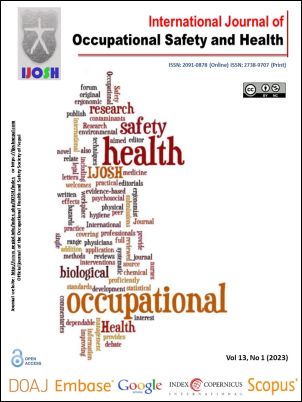Epidemiological pattern of corneal foreign bodies and utilization of protective eye devices: a hospital-based cross-sectional study
DOI:
https://doi.org/10.3126/ijosh.v13i1.45153Keywords:
Cornea, Foreign body, Protective device, workplaceAbstract
Introduction: A corneal foreign body is the most common occupational ocular injury that can cause secondary infection or scars on the visual axis, decreasing vision. The study aimed to find out practices of wearing protective eye devices in the workplace and the factors influencing the utilization of such devices among patients with corneal foreign body (CFB) injury.
Methods: This cross-sectional study was conducted in a tertiary eye hospital in Bhaktapur from April 2021 to August 2021. All patients with CFB attending the hospital were included in the study. CFB was removed with ocular examination under a slit lamp biomicroscope, and face-to-face interview was conducted.
Results: Among 142 patients, only one was female, and 41.5% had a previous history of CFB. The most common CFB particle was metallic (n=124, 87.3%),. Three-fourths (75.1%) of patients were not using eye-protective devices at the time of injury, and 45.1% tried physically removing the CFB in a harmful way. Nearly two in five (19.7%) had used topical antibiotics eye drops before presenting for CFB removal. Sixty-six (46.5%) reported never wearing any protective eye devices, and the main reason for not-wearing was the unavailability (48.4%) of such devices in their workplace. The awareness of the need for protective eye devices (p<0.001) was significantly associated with using protective eye devices during work.
Conclusion: The workers should be made aware of the consequences of harmful practices following CFB injury. The workers should wear protective eye devices to minimize the risk of ocular injury and consequent visual impairment.
Downloads
Downloads
Published
How to Cite
Issue
Section
License
Copyright (c) 2023 Samata Sharma, Deepak Khadka, Arjun Shrestha, Nirsara Shrestha, Barsha Suwal, Diwa Hamal, Rajan Shrestha, Bijay Khatri

This work is licensed under a Creative Commons Attribution-NonCommercial 4.0 International License.
This license enables reusers to distribute, remix, adapt, and build upon the material in any medium or format for noncommercial purposes only, and only so long as attribution is given to the creator.





